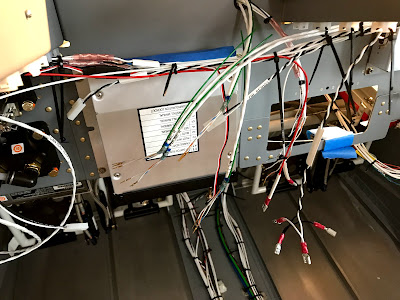- The avionics wiring harness (except for engine sensors) is complete! I will be installing it soon.
- Finished GTN 650 data wiring.
- For power wiring on GTN 650, which requires splicing a larger wire into two or three wires multiple times, I decided to use the solder splices. They worked great. Next time around I will use them more often - much easier than the soldering iron!
- Connected GTN 650 configuration module and fan connector wiring
- Assembled all GTN 650 backshells
- Organized wire harness
- Added power and ground wires to GMA 245R audio panel connector and GTX 23R transponder connector
GTX 23R connector ready for back shell:
Avionics wiring harness ready to be installed:
A lot of shield drains on the main GTN 650 connector:
GTN 650 backshell (note config module on left and fan connector):
Solder splices work great!
Old school solder splicing:
















































